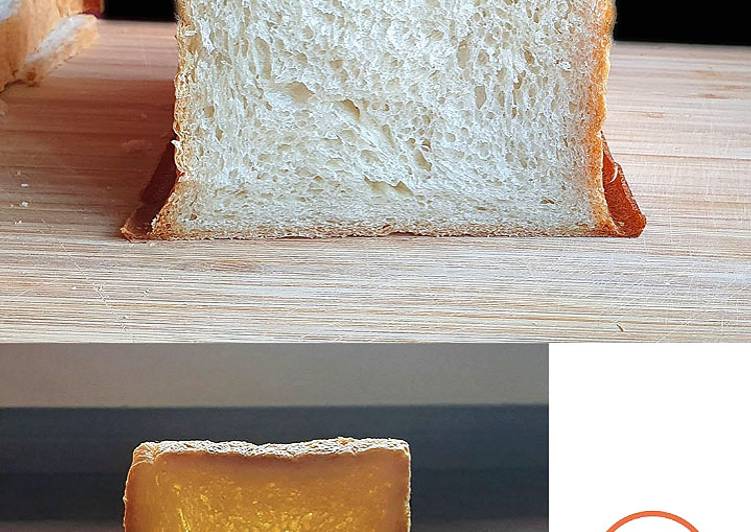
Hello everybody, it’s me, Dave, welcome to my recipe site. Today, we’re going to prepare a special dish, how to make shokupan | japanese sandwich bread. One of my favorites. For mine, I am going to make it a little bit tasty. This is gonna smell and look delicious. Japanese Sandwich Bread is one of the most well liked of current trending foods in the world. It’s simple, it is quick, it tastes yummy. It is appreciated by millions daily. Japanese Sandwich Bread is something that I have loved my whole life.
Two types of Japanese egg sandwich - egg salad sandwich and Japanese rolled omelette sandwich recipe with step by step photos and tips to make it perfect. THE SOFTEST SANDWICH BREAD - SHOKUPAN JAPANESE MILK BREAD This sandwich bread recipe is the Japanese sandwich bread shokupan, also known as the Hokkaido. Shokupan, or sometimes called Japanese Sandwich Bread is a bread that somehow manages to be both light and fluffy, yet with a bouncy crumb at the same time.
To begin with this particular recipe, we have to prepare a few components. You can cook how to make shokupan | japanese sandwich bread using 11 ingredients and 17 steps. Here is how you cook it.
The ingredients needed to make How To Make Shokupan | Japanese Sandwich Bread:
- Take Yudane:
- Get 75 g Bread Flour,
- Make ready 125 g Boiling Water,
- Prepare Dough:
- Take 325 g Bread Flour,
- Get 30 g Demerara Sugar,
- Prepare 7 g Sea Salt,
- Get 6 g Active Instant Dry Yeast,
- Get 50 g Heavy Whipping Cream,
- Get 200 g Water,
- Get Room Temperature Softened Unsalted Butter, 25g + More For Greasing
Japanese Egg Salad Sandwich - Soft sandwich bread filled with a creamy egg salad filling, with a jammy soft boiled egg. Cheesy potato and bacon Scotch Eggs. Soft and fluffy Japanese-style egg salad sandwiches, also known as Tamago Sando. These taste like the popular ones found at convenience stores in Japan.
Instructions to make How To Make Shokupan | Japanese Sandwich Bread:
- Prepare the yudane.
In a shallow bowl, add flour and water.
The water has to be boiling.
Stir to combine well.
- It should be a sticky roux.
Spread out to cool down faster.
Cover with a damp lint-free kitchen towel.
Set aside to cool down to room temperature.
- Prepare the dough.
In a large bowl, combine flour, sugar, salt and yeast well.
Do not add the yeast directly on the salt. It will kill the yeast.
Gradually pour the water and cream into the flour mixture while still mixing with a spatula.
- Once it becomes a dough, knead the dough inside the bowl until all the nooks and crannies of flour are kneaded into the dough, about 5 mins.
Transfer onto a lightly floured surface.
Add in the yudane.
- Knead for about 5 mins until the yudane is fully incorporated.
Add in the butter.
Continue kneading for another 3 to 5 mins.
Do take note that the yukane and butter has to be at room temperature.
- The dough should be tacky, fluffy, smooth and it should pass the "window-pane" test.
If the dough is too dry, add in water, 1 TBSP at a time. If the dough is too sticky, add in flour, 1 TBSP at a time.
Lightly grease the bowl with some butter.
- Transfer the dough back to the greased bowl.
Cover with a damp lint-free kitchen towel and let rise for 30 mins.
It should slightly risen.
Punch down the dough and fold the top, sides and bottom to the center.
Flip, cover and let rise for 1 hr.
- This process is sorta to ensure that the yeast is activated.
The dough should doubled in size.
You can do a test by poking a floured finger into the dough. If it doesn't spring back, the yeast is activated properly and the dough is ready.
Transfer the dough onto a lightly floured surface.
Divide the dough into 2 equal pieces.
- Form each piece into balls.
Cover with a lint-free kitchen towel and let rest for 15 mins. This is call the bench rest which allows the gluten to relax.
Grease bread pan with butter.
- Pat down a dough ball to an oblong disc.
Fold the top 2/3 way to the bottom.
Using the heel of your palm, gently press down the sim.
- Fold the bottom 2/3 way to the top.
Using the heel of your palm, gently press down the sim.
Rotate 90 degrees.
- Fold the top 2/3 way to the bottom.
Gently pinch down the sim.
Fold the bottom 2/3 way to the top.
- Gently pinch the sim.
Roll the dough simmed side down to form a ball.
- Transfer into the greased bread pan.
Repeat the process for the remaining dough.
You will have 2 dough balls, side by side in your loaf pan.
Cover with a damp lint-free kitchen towel and let rise for 40 to 50 mins.
- Preheat oven to 200 degree celsius or 400 fahrenheit.
The dough balls should rise about 1/2 inch away to the top of the loaf pan.
Close the lid and wack into the oven.
- Bake for 40 to 1 hr or until the crust is golden brown.
Remove from oven.
Immediately unmold onto a wire cooling rack.
- Set aside to cool down completely before slicing.
Use this sandwich bread for your sandwich adventures, or simply make a toast. I just simply spread my gianduja.
These are just egg salad sandwiches, not sure how they differ from the American version. Short-grain Japanese rice is quite different from long-grain basmati or jasmine rice, so achieving the right texture — glossy and tender but not sticky — calls for a particular cooking method. A fancy rice cooker makes the process easy, but it isn't a necessity. If you'd like to learn how to bake bread, here's a wonderful place to start. This easy white bread recipe bakes up deliciously golden brown.
So that’s going to wrap this up for this exceptional food how to make shokupan | japanese sandwich bread recipe. Thanks so much for your time. I’m confident you will make this at home. There is gonna be more interesting food at home recipes coming up. Remember to bookmark this page on your browser, and share it to your family, colleague and friends. Thanks again for reading. Go on get cooking!


